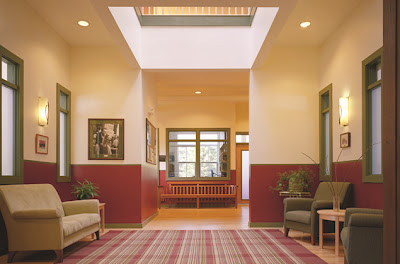Digital Crayon: Article 8 – Sustainablity
posted by David Epstein, AIA, LEED AP
Sustainability, Green Schools, Environmental Design – it goes by many names these days. Everybody wants it for their schools, but few schools understand what it means and the level of commitment required to make it happen. We believe sustainable design is a great fit for schools because it creates healthy productive environments that help students excel and are resource and earth-friendly facilities that are durable and energy efficient. With so many schools teaching environmental stewardship and global citizenship, it is a unique opportunity demonstrate its commitment to these concepts. At its highest level, we can create buildings that teach these fundamental ideas through their thoughtful design.
We use the LEED (Leadership in Energy and Environmental Design) Green Building Rating System as the starting point in our discussions. Over the past several years, it has become the defacto green building credential. It provides a useful conceptual framework by which to assess environmental design opportunities at a school.
LEED is divided into five primary categories: Sustainable Sites, Water Efficiency, Energy and Atmosphere, Materials and Resources and Indoor Environmental Quality. There are also Innovation and Regional credits available as well. In each of the five categories, there are credits that are mandatory and some that are optional. The idea is to select the credits that make sense for your project. Each credit is documented and reviewed by the LEED accrediting group. Based on the number of credits accepted, a project can receive a Certified, Silver, Gold or Platinum certification.
 What does LEED look for? In Sustainable Sites, credits are available for projects to be located in dense area near mass transit, on brownfield sites, to maximize open space and restore habitat. LEED also encourages responsible storm water management. This is a big issue when storm water runs on the surface or in pipes directly to nearby waterways, carrying pollutants, fertilizers and pesticides with it. In this case, green design is about being good for the environment. Implementation costs money and there is no financial payback. This is when commitment to the goals of sustainability is strictly about environmental impact and the future of our communities.
What does LEED look for? In Sustainable Sites, credits are available for projects to be located in dense area near mass transit, on brownfield sites, to maximize open space and restore habitat. LEED also encourages responsible storm water management. This is a big issue when storm water runs on the surface or in pipes directly to nearby waterways, carrying pollutants, fertilizers and pesticides with it. In this case, green design is about being good for the environment. Implementation costs money and there is no financial payback. This is when commitment to the goals of sustainability is strictly about environmental impact and the future of our communities.
The Water Efficiency credits encourage the reduction of potable water use for landscaping, wastewater and process water use. The Energy and Atmosphere section addresses energy performance, and is where the mother lode of credits are available. Central to LEED’s approach to energy performance is the use of a computer energy model, that predicts the building’s energy performance. This interactive tool allows the design team to optimize the building performance by looking at the interrelationship of the building design envelope, HVAC systems, and site orientation. On-site renewables and green power are also encouraged.
 In Materials and Resources, the emphasis is on using regional, recycled, low-emitting and rapidly renewable materials.
In Materials and Resources, the emphasis is on using regional, recycled, low-emitting and rapidly renewable materials.
The Indoor Environmental Quality section tends to start quite a conversation, especially in international schools. Here LEED shows its U.S. bias, where mechanical ventilation in classrooms is common. In most of the world, however, it is not. In these places, ventilation is achieved with operable windows. The issue becomes in the winter, when the heat is on and windows are closed. The same is true in the summer with schools that have split system air-conditioning, which does not bring in fresh air. We breathe in oxygen and exhale carbon dioxide. In these sealed environments, the carbon dioxide level can build up resulting in drowsiness. We believe effective ventilation strategies in all temperature conditions are key to creating healthy, productive environments.
LEED is but one path to making our buildings more sustainable. In the UK, they use a similar system called BREEAM. In any case, we always the welcome the opportunity to talk more about this important issue, so don’t hesitate to chime in.
Next Article – Article 9 – School Safety and Security
Last Article – Article 7 – Technology in Schools